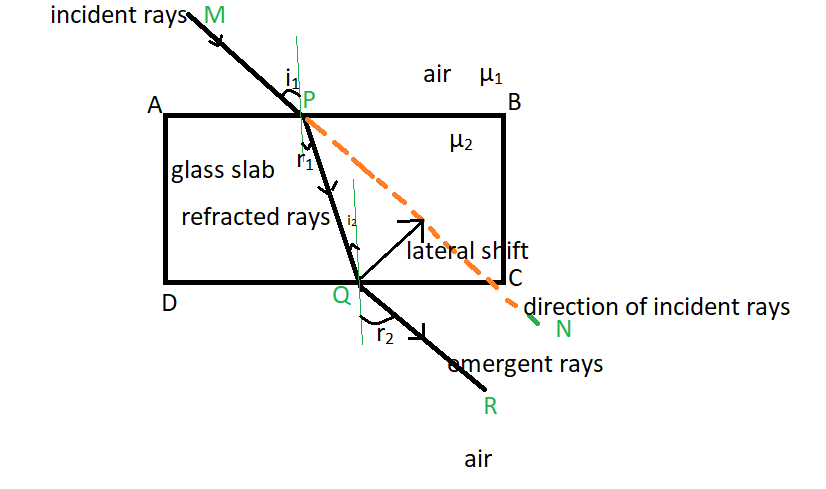
Explain refraction of light and lateral shift using a rectangular glass slab with figure.
Answer
592.2k+ views
Hint: Learn the definition of refraction then learn what happens when the light travels from denser to rarer medium or rarer to denser medium. Learn how to draw perpendicular and parallel lines.
Complete step by step answer:
Refraction of light and lateral shift using a rectangular glass slab,

In case of rectangular slab, light first travels from air to glass and then back from glass to air. So there are two refractions. First, the ray of light travels from air to glass. Hence, it travels from a rarer medium to a denser medium. So the first refracted ray bends towards normal.
After first refraction, the ray of light travels from glass to air. Hence it travels from a denser medium to a rarer medium. So the second refracted ray also called emergent ray bends away from normal.
Now, for getting lateral shift, we extend the original incidence ray and bring it towards emergent ray. Here, we can observe that the original ray and the emergent ray are parallel to each other. The angle made by the emergent ray with the normal is called the angle of emergence. And the perpendicular distance between the original incidence ray and emergent ray is called lateral shift.
Note: Refraction – when a light ray is incident on a surface separating two transparent media, the ray bends at the time of changing the medium. The angle of incidence i and the angle of refraction r follow Snell’s law
\[\dfrac{\sin i}{\sin r}=\dfrac{{{v}_{1}}}{{{v}_{2}}}=\dfrac{{{\mu }_{2}}}{{{\mu }_{1}}}\]
Where $v_1$ and $v_2$ are speeds of light in media 1 and 2 respectively and $µ_1$, $µ_2$ are refractive indices of media 1 and 2 respectively.
Complete step by step answer:
Refraction of light and lateral shift using a rectangular glass slab,

In case of rectangular slab, light first travels from air to glass and then back from glass to air. So there are two refractions. First, the ray of light travels from air to glass. Hence, it travels from a rarer medium to a denser medium. So the first refracted ray bends towards normal.
After first refraction, the ray of light travels from glass to air. Hence it travels from a denser medium to a rarer medium. So the second refracted ray also called emergent ray bends away from normal.
Now, for getting lateral shift, we extend the original incidence ray and bring it towards emergent ray. Here, we can observe that the original ray and the emergent ray are parallel to each other. The angle made by the emergent ray with the normal is called the angle of emergence. And the perpendicular distance between the original incidence ray and emergent ray is called lateral shift.
Note: Refraction – when a light ray is incident on a surface separating two transparent media, the ray bends at the time of changing the medium. The angle of incidence i and the angle of refraction r follow Snell’s law
\[\dfrac{\sin i}{\sin r}=\dfrac{{{v}_{1}}}{{{v}_{2}}}=\dfrac{{{\mu }_{2}}}{{{\mu }_{1}}}\]
Where $v_1$ and $v_2$ are speeds of light in media 1 and 2 respectively and $µ_1$, $µ_2$ are refractive indices of media 1 and 2 respectively.
Recently Updated Pages
Why are manures considered better than fertilizers class 11 biology CBSE

Find the coordinates of the midpoint of the line segment class 11 maths CBSE

Distinguish between static friction limiting friction class 11 physics CBSE

The Chairman of the constituent Assembly was A Jawaharlal class 11 social science CBSE

The first National Commission on Labour NCL submitted class 11 social science CBSE

Number of all subshell of n + l 7 is A 4 B 5 C 6 D class 11 chemistry CBSE

Trending doubts
What is meant by exothermic and endothermic reactions class 11 chemistry CBSE

10 examples of friction in our daily life

One Metric ton is equal to kg A 10000 B 1000 C 100 class 11 physics CBSE

1 Quintal is equal to a 110 kg b 10 kg c 100kg d 1000 class 11 physics CBSE

Difference Between Prokaryotic Cells and Eukaryotic Cells

What are Quantum numbers Explain the quantum number class 11 chemistry CBSE




